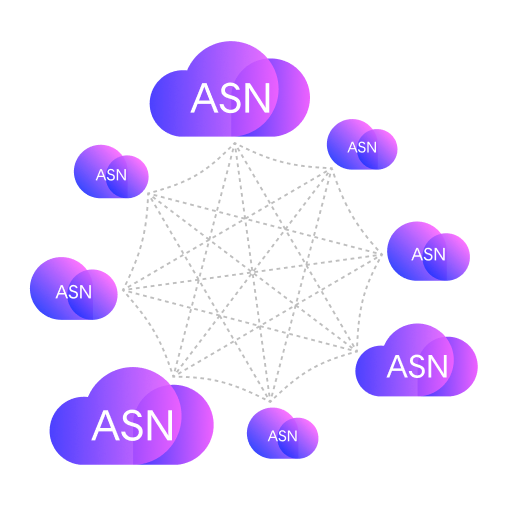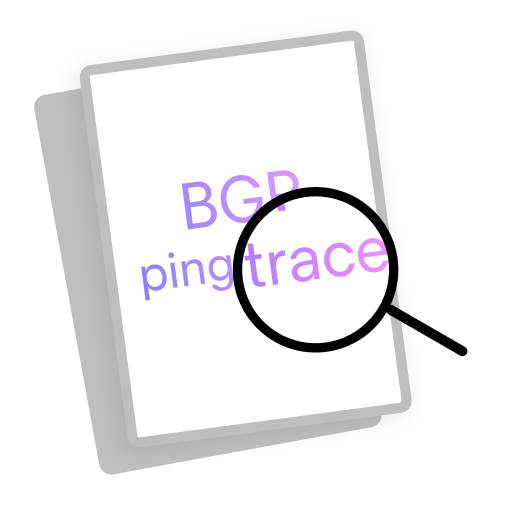The Internet backbone is a network of public networks, or autonomous systems (AS) connected to each other. Autonomous systems are essentially a unique collection of IP addresses/address blocks and network hardware within a common administrative domain. They are like independent, digital countries – each with a distinct geographical footprint, infrastructure, routing policy, and borders.
For full Internet access, a connection needs to either be established directly with all of these networks, or by a connecting through a network that is connected in some way to all of the other networks on the Internet. Generally, retail or enterprise users buy access from a single service provider and effectively become a part of that network (the service provider lends the enterprise IP addresses from its network block, but the ownership of them does not change).
Autonomous systems communicate route information and steer traffic to each other using a protocol known as the Border Gateway Protocol, or BGP.
IP Transit is a service by which networks have access to the rest of the Internet via BGP. In contrast to peering, where AS networks exchange only their own customer routes (on a mutual benefit and cost neutral basis), IP Transit is a commercial service whereby one network provides access to the entire Internet routing table (or a subset thereof), in return for payment. IP Transit services are typically charged on a usage basis, or by flat monthly fee.
IP Transit services are based on BGP, and therefore anyone buying IP Transit is required to operate and administer their own AS and IP addresses. A prerequisite for this is good knowledge of BGP routing and hardware capable of running it.
In contrast to services based on default routing, such as IP Transit affords larger networks greater routing flexibility and control via the levers BGP provides.

The Internet structure is defined as a kind of hierarchical order where Tier-1 networks are on the top of the Internet ecosystem. There are only around 20 Tier-1 networks that build this Internet “core”. The simplest and maybe the most dispersed definition of a Tier-1 network is that the Tier-1 network is a network that can reach every other network on the Internet without paying for either IP transit or network peering.
IP transit and IP peering are the two main interconnect relationships that are established between different Internet Service Providers (ISP) when securing full access to the Internet routing table. They form the foundation of all Internet access services. An ISP looking to provide global Internet connectivity to end-users can choose between building their own IP backbone network and peering with other ISPs, or simply just buying global IP Transit from someone that has an already established IP transit network. To achieve the best balance of cost and performance, most use a combination of the two.
Let’s look at the definitions of IP Transit and IP peering.
IP Transit is the exchange of Internet IP traffic where one party pays another for access to a network (and the networks connected to it), that is considered as having the highest intrinsic value (based on a combination of geographical and logical assets). This may, for example, involve access to all, or a larger part of the wider Internet, or a subset of larger/unique end-customers. Where one network has a higher value than the other network, so-called ‘upstream’ IP Transit is purchased by the network with the lowest intrinsic value. IP Transit is a wholesale service, available only to Autonomous System (AS) number owners running the Border Gateway Protocol (BGP). Non-AS owners can also get Internet connectivity by acquiring services such as Dedicated Internet Access, DIA – also known as IP Connect within Arelion, without running BGP. The benefits for ISPs are, amongst other things, a reduced capital expenditure risk and lower yearly recurring costs. There is also less administrative overhead and required technical resources.
Peering, on the other hand, is the exchange of IP traffic between networks without the flow of payments (known as settlement-free peering), or for a fee that compensates for any differences in intrinsic network value (known as paid peering). Settlement-free peering agreements are based on two parties having networks of equal intrinsic value and where they are mutually dependent on each other. A peering interconnection requires that routers and other related equipment are installed at the connection points of the peering parties’ respective networks.
Most ISPs need to buy IP Transit services from some of the largest Internet backbone networks to be able to offer the full Internet routing table to their end users. For some of the more local or regional traffic, they could benefit from traffic exchange at local peering exchange points (also known as IXs). To reach these peering points, Arelion offers a service called IX Connect.
|
|
Carrier-grade SLA, including: installation, availability, round-trip delay, packet loss |
|
|
Secure customer portal |
|
|
Three route options: Global Connect (global routes), Euro Connect (European customers and peers) and Content Connect (global customer routes) |
|
|
IPv4 and IPv6 domains - dual stack |
|
|
Secure Internet routing – minimized routing threats from BGP Hijacks and Route Leaks |
As an “open network,” the Internet requires a continuous and collaborative effort between all stakeholders to sustain the resilient, reliable, and secure infrastructure necessary to power the global economy.
At Arelion, we implement best practices and enhanced security measures for routing and exchanging traffic with other public networks.
Contact our us to learn more about our most recent efforts to enable emerging Internet security techniques such as Resource Public Key Infrastructure (RPKI), our collaboration with the Internet Society (ISOC), and the wider BGP community for route security and filtering.
Secure by design features |
|---|
|
|
NOC situated in a well secured and connected building with multiple power sources |
|
|
Physical and logical security from design to deployment |
|
|
A network-wide Acceptable Use Policy (AUP) |
|
|
Customer Service authentication procedures |
|
|
Clear customer data handling policies |
IP Transit provides comprehensive access to the entire Internet routing table, offering greater flexibility and control for networks. Unlike IP peering, which is typically mutual, cost-neutral, and limited in nature, IP Transit ensures a network can reach all other networks on the Internet, often with more stable and predictable connectivity, which is crucial for businesses needing reliable global Internet access.
IP Transit services are generally charged based on usage or a flat monthly fee, providing a predictable cost structure. This can be more economical for businesses that require extensive and reliable Internet access compared to building and maintaining peering agreements, which may involve significant administrative and operational overhead.
Tier-1 networks are the backbone of the global Internet, capable of reaching every other network without paying for IP Transit or peering. They provide short-hop connectivity and low-latency routing, making them essential for international organizations requiring robust and resilient Internet connections. Their extensive reach and reliability make them critical in ensuring seamless global connectivity.

